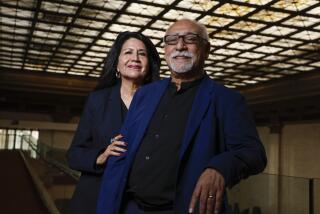ARTS COUNCIL CUTS SUPPORT OF STATE DANCE COMMUNITY
- Share via
SACRAMENTO — The California Arts Council has delivered a stunning blow to the state’s dance community, even as the agency has handed out this year’s biggest bundle of grant dollars to arts groups from San Diego to Eureka.
Meeting at the Crocker Art Museum here Thursday and Friday, the council awarded about 660 arts groups $8.4 million in organizational grants for fiscal 1987-88, giving the top awards to the Los Angeles Philharmonic ($295,344) and the San Francisco Symphony ($292,307).
But the agency dropped by nearly one-third the number of dance companies approved for state touring funds. The council’s action--which cut the number of dance companies listed in its new Touring Artists Directory to 24 from 33 last year--is likely to force some companies to curtail their on-the-road performances.
In all, 57 state dance troupes applied for spots on the council’s list. Almost one-third of those that did not make it, 13, are Los Angeles-based groups.
“I am deeply saddened by this,” Darlene Neel, company manager of the Bella Lewitzky Dance Company, told The Times. “What you want is that list to be big. It should create a kind of wonderful menu.” (The Lewitzky was included on the new roster.)
The council’s directory is a roster of 139 dance, music and theater troupes eligible for state funds to partially cover the expenses of touring engagements. The lists are used by commercial theaters, universities or other arts presenters, who receive money directly from the state.
Both the directory’s music and theater listings increased this year.
Among the local dance groups excluded from the roster, valid through 1990, are the Los Angeles Chamber Ballet, Loretta Livingston and Dancers, the Los Angeles Contemporary Dance Theater, Mary Jane Eisenberg and SHALE and Sarah Elgart and Company. The last two companies had previously appeared for at least one year on the touring roster, which has a subsidy ceiling of $20,000.
In addition, the council nearly dropped the long established Lola Montes and Her Spanish Dancers troupe, a regular on the list since its 1983 inception. An emotional appeal made by Neel, who serves on a council organizational grant evaluation panel, reinstated the troupe. However only half the $10,000 that would have been earmarked for Montes will be made available to her troupe’s presenters.
The council’s dance touring panel, whose five volunteer members, all arts professionals, recommend groups to be included on the roster, base their evaluations on artistic achievement and touring history.
First-time touring panelist Akili Denianke, director of an Oakland African music and dance group, told the council: “I think in the past more attention has been paid by the panels to artistic quality rather than administrative strength,” crucial to profitable touring. “And some groups on the roster for a long time were not attracting large audiences,” or, troupes may offer a fine lecture demonstration, but not a full two-hour performance. “Sometimes an individual is good, but the entire company together shows a lot of unevenness.
“In Lola’s case, the touring was just not there anymore,” Denianke said.
Countered Neel, her voice trembling with emotion: “Lola has been able to do what few others have. Columbia (Artists Management Inc.) toured her for years and years, and on her own, she has spent multiple weeks touring every year for 21 years. She is a role model for her peers in our Los Angeles community.”
Montes, who could not be reached for comment, still heads one of the most extensive touring dance companies in Los Angeles, traveling in and outside of California, Neel added in an interview. Council touring program manager Philip Horn noted that “touring is a major portion” of Montes’ troupe’s current income.
Though the touring panel uses different criteria to evaluate arts groups, Montes’ company also received the highest ranking (a 4 on a scale of 1 to 4) and a $5,850 grant from the its organizational grant program, which awards groups primarily for artistic excellence, noted Neel.
Similarly, two groups to be left off the dance roster won high ratings and organizational grants: The Los Angeles Contemporary Dance Theater earned a 4 and a $12,090 grant, and the Los Angeles Chamber Ballet made a 4-minus, winning an $8,009 award.
“We’re hard-pressed to understand the touring panel’s objection,” Victoria Koenig, co-artistic director of the chamber ballet troupe, told The Times in a telephone interview. “We’ve been touring for two years and this year was our busiest yet. We have a solid month this winter booked for 14 performances in New Mexico and Arizona. We have a booking manager and are getting calls (for potential engagements) from all over the country.” Exclusion from the roster could mean “thousands” of dollars in revenue, added Koenig, who said she may appeal the council’s action. She, like Neel, also objected to the method by which the touring panels often make their evaluations--watching video tapes rather than live performances.
“Video is not a substitute” for site visits, Koenig asserted. Added Neel, who said the Lewitzky company tours internationally about 20 weeks a year: “You wouldn’t buy us from our video.” Both women said their companies do not place high priority on producing expensive video tapes.
Troupe evaluations, written by various touring panel members obtained by The Times, showed numerous comments similar to several groups rejected from the roster such as “Could not gather enough information from the video . . . the artistic quality of the performance on the tape does not support the reputation of this company.”
“Maybe the touring panel should be expanded,” Koenig said, “I don’t really think that five people can see all there is to see in person.”
Still, added Neel after the meeting, dance companies’ managerial skills (knowing how to publicize tours or hang “150 stage lights” before a performance) commonly lag behind their artistic skills, and, “We must strengthen our administration in dance organizations.”
(Other local dance groups that were included on the 23-troupe dance roster include the Aman Folk Ensemble, the Jazz Tap Ensemble, the Floricanto Dance Theatre and the Joffrey Ballet, which has home bases in New York and Los Angeles.)
When the council finally gave away $8.4 million (out of its $14.5 million budget for the 1987-88 fiscal year) in organizational grants Friday, Los Angeles arts groups, in addition to the Los Angeles Philharmonic, claimed several top awards. These were given in the council’s “Support to Prominent Organizations” grant category which this year allotted about $3 million to 28 groups with budgets $1 million or more.
Lining up behind the Philharmonic came the Center Theatre Group/Mark Taper Forum ($153,700), the Los Angeles County Museum of Art ($152,549), the Museum of Contemporary Art ($86,090), and the Los Angeles Theatre Center ($57,855).
Other top winners outside of Los Angeles, in addition to the San Francisco Symphony, were the San Francisco Opera ($288,261), the Fine Arts Museums of San Francisco ($187,071), the San Francisco Museum of Modern Art ($122,916), the San Francisco Ballet ($167,471), San Diego’s Old Globe Theatre ($105,675), San Francisco’s Exploratorium ($120,444) and Costa Mesa’s South Coast Repertory, ($63,077).
This year’s other organizational grants, totaling $5.4 million to about 630 organizations, were awarded Friday to support small, medium and large arts groups and artists working in schools, in community organizations, such as youth development agencies, and in social institutions, such as prisons.
More to Read
The biggest entertainment stories
Get our big stories about Hollywood, film, television, music, arts, culture and more right in your inbox as soon as they publish.
You may occasionally receive promotional content from the Los Angeles Times.










